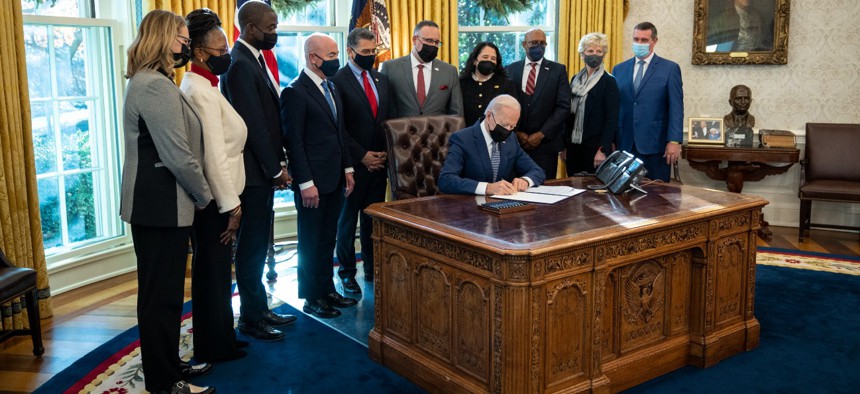Making the Customer Service Executive Order Really Work

President Biden signs the executive order on customer service in the Oval Office on Dec. 13. Drew Angerer/Getty Images
Among the keys: making permanent the flexibility to pursue innovation through technology and multi-sector partnerships.
On December 13, the Biden administration issued a sweeping executive order designed to drive new and better ways to improve the “customer,” or citizen, experience with government agencies. According to the order, the focus of these efforts will be on “modernizing programs, reducing administrative burdens, and piloting new online tools and technologies that can provide a simple, seamless and secure customer experience.” It is an ambitious and important initiative that sets bold objectives across a wide spectrum of federal programs from health to retirement, and from poverty to passports. It seeks to attack some of the most pernicious challenges in government management, many of which were defined in a compelling article by Annie Lowrey in The Atlantic (“The Time Tax”) and echoed by President Biden when he signed the order.
As with any major reform effort, success will be defined in many ways and determined by many factors. But clearly, early and quick “wins” are critical. The good news is that, despite the complexity of many of the challenges, the opportunities for those wins are available. The key is to identify and jump on them without delay, but to also do so in a truly strategic manner.
Specifically, let’s not jump into the business of fixing front end apps and websites until we’ve fully defined all of what really makes up the citizen experience—and what drives it. Any efforts to improve the technology and tools available to citizens must not only be underpinned by a comprehensive assessment of the disaggregated array of critical citizen services programs, but also by an equally comprehensive assessment of the underlying business processes and policies that govern the programs themselves.
General Services Administration Administrator Robin Carnahan’s declaration that “we’re going to fix the damn websites” is spot on. But real fixes, real improvements in the full customer experience, are more about the underlying processes and policies that govern the citizen or customer journey. It’s both the toughest part of the puzzle and the one with the biggest payoff.
That said, the pandemic has helped to highlight some of the most glaring gaps in the delivery of citizen services, particularly those that are federally funded and state administered. The lessons learned as a result can form the basis for action. For example, the pandemic-driven flexibilities that allowed state and local governments to hire part-time employees, rehire retirees and contract for private sector support for an extraordinary surge in back-logged benefits claims expired four months ago. Meanwhile, states and cities continue to face backlogs of millions of claims coupled with massive staffing shortages (Denver is down to just 70 caseworkers in its human services agency). Why has the authority not been reinstated? After all, the demand is not going away and most experts estimate it will take years to fully address it.
Additionally, there are already critical funds and opportunities in place to address other challenges, but they have yet to be acted on. As one example, in the face of many reports of problems with the implementation of unemployment insurance programs (most of which involve organized technology incursions as opposed to individual fraud), earlier this year Congress appropriated $2 billion to modernize unemployment insurance and reduce fraud while improving access to benefits for unemployed claimants. To date, only $140 million has been committed to the states. Why? The systemic improvements enabled by the funds would go a long way toward improving claimants’ experiences during very difficult times.
The bottom line is that because of these, and other pandemic-related initiatives, we now know how effective the flexibility to pursue innovation through technology as well as multi-sector partnerships—many of which are currently proscribed by federal administrative rules and limitations—can be. Making that flexibility permanent, within the bounds of a set of immutable guard rails, all centered around the ethos of service to beneficiaries, would pay real dividends in a surprisingly short period of time and for decades to come.
President Biden’s order covers three dozen programs across 17 agencies. It could catalyze the most significant reforms in decades to government management and, more importantly, to the plethora of ways in which citizens interact with government at all levels. Its shear scope is exciting and full of potential. Some enhancements, such as those described above, can be implemented quickly and help meet the executive order’s directive that substantial results be recognized in a year. But the truth is that it will take much longer to really take hold across the complex, disaggregated array of programs and services. Quick fixes won’t meet the mandate; smart strategy and the long view will. President Biden has provided the framework. Now, let’s get to work.
Stan Soloway is president of Celero Strategies LLC and chairman of the Center for Accountability, Modernization and Innovation, which advocates for driving innovation in citizen services.






